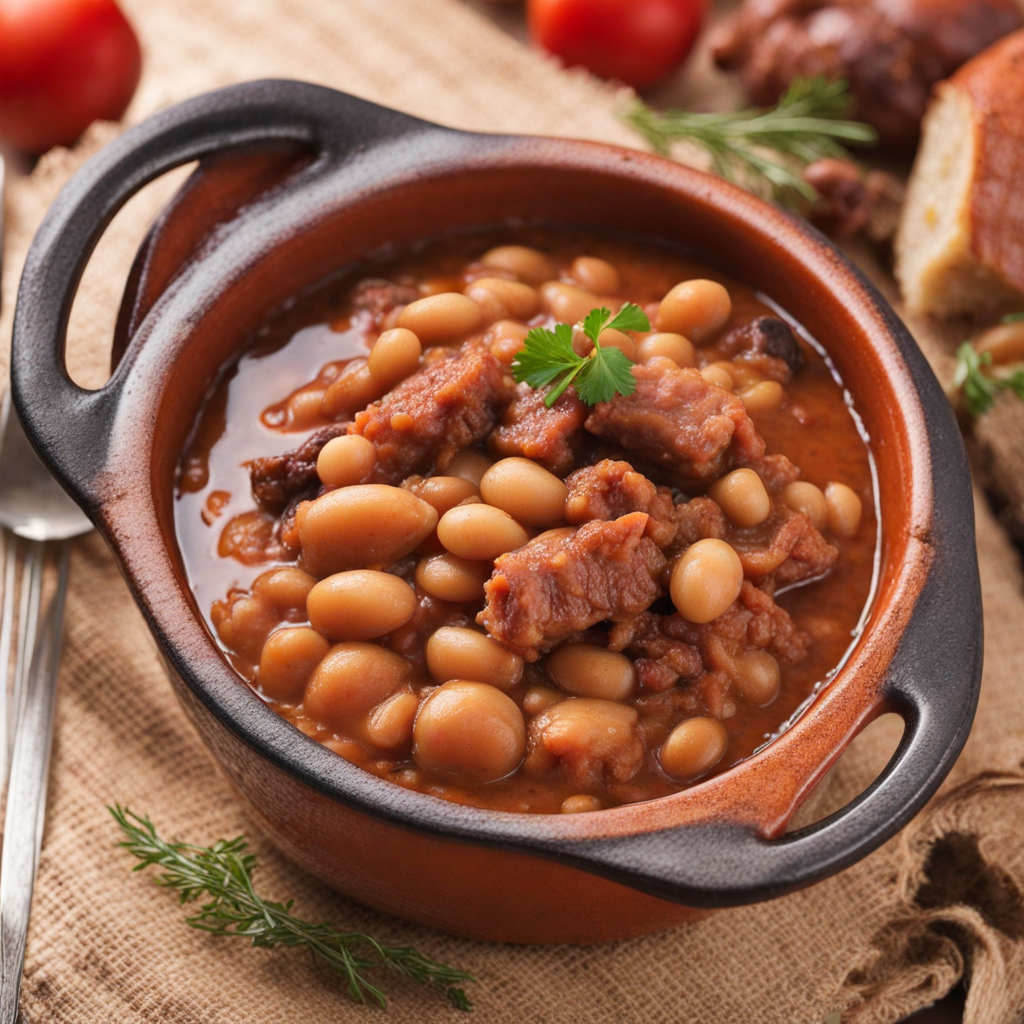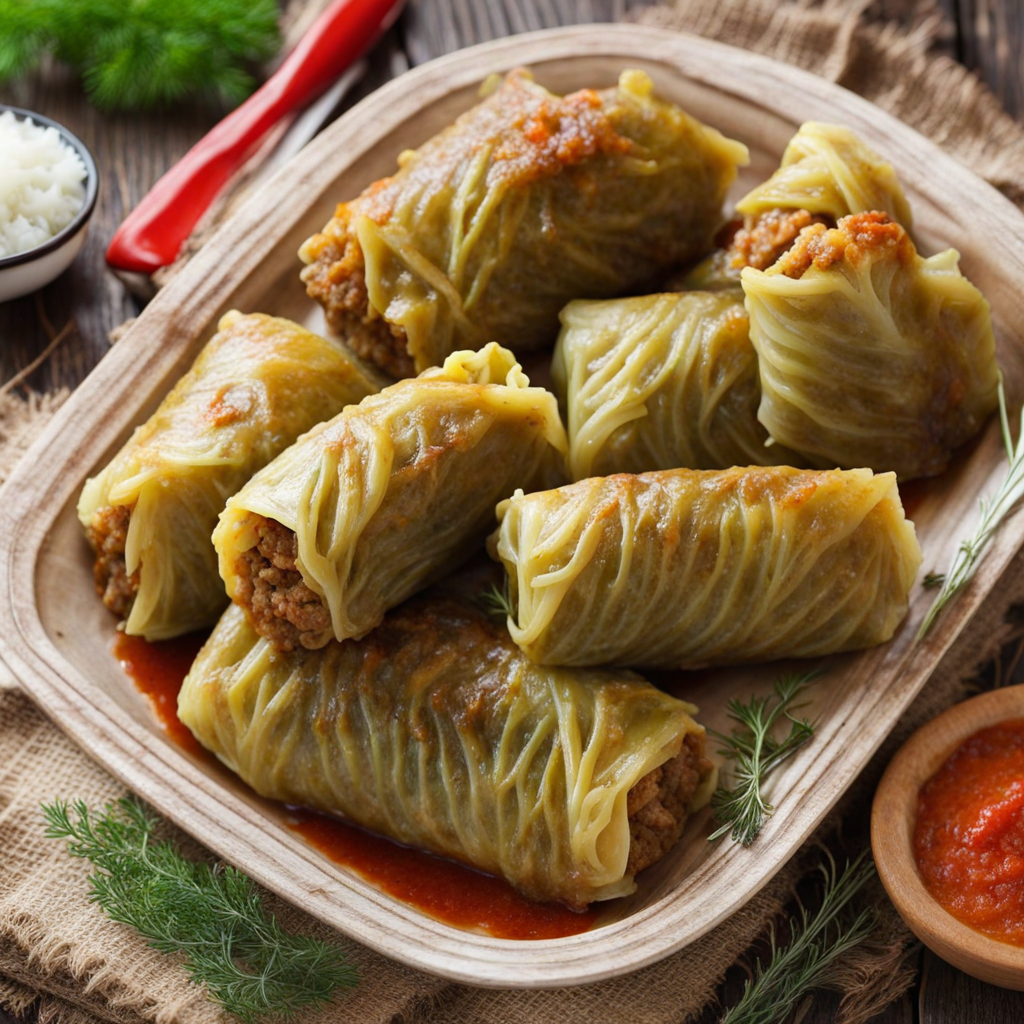Stuffed Cabbage Rolls
Stuffed Cabbage Rolls, or "Sarmale" as they are known in Romania, are a beloved traditional dish that encapsulates the heart of Romanian home cooking. These delectable rolls consist of tender cabbage leaves filled with a savory mixture of ground meat, usually pork or beef, combined with rice, herbs, and spices. The process begins with carefully blanching the cabbage leaves until they are pliable, allowing them to cradle the flavorful filling. The rolls are then tightly packed and simmered in a rich tomato sauce, often infused with smoked meats or bacon, which adds depth and smokiness to the overall flavor profile. The beauty of Sarmale lies in its harmonious blend of ingredients and the slow-cooking method that allows the rolls to absorb the tangy and savory notes of the sauce. As they cook, the cabbage becomes tender and slightly sweet, complementing the filling's savory and aromatic qualities. Each bite offers a delightful contrast between the juicy, seasoned meat and the subtle acidity of the tomato sauce, making it a comforting and satisfying dish that warms the soul. Served hot, Stuffed Cabbage Rolls are often accompanied by a dollop of sour cream and a sprinkle of fresh dill, enhancing the dish's complexity and adding a creamy texture. This rustic meal is typically enjoyed during festive occasions or family gatherings, showcasing the importance of togetherness in Romanian culture. With every bite, you embark on a culinary journey that reveals the rich traditions and flavors of Romania, making Sarmale a must-try for anyone eager to explore new tastes.
How It Became This Dish
The History of Sarmale: A Culinary Treasure of Romania Sarmale, a beloved Romanian dish, is a culinary embodiment of the country’s rich history and diverse cultural influences. These savory rolls, traditionally made with pickled cabbage leaves stuffed with a mixture of minced meat, rice, and spices, are not merely a staple of Romanian cuisine; they are a symbol of community, tradition, and the passage of time. #### Origins and Early History The origins of sarmale can be traced back centuries, with roots extending into various culinary traditions across Eastern Europe and the Mediterranean. The name "sarmale" derives from the Turkish word "sarmak," which means "to wrap" or "to roll." This etymology hints at the dish's Ottoman influence, as the Turkish Empire played a significant role in shaping the culinary landscape of Eastern Europe. Historically, the practice of wrapping food in leaves dates back to ancient civilizations. The Greeks and Romans used grape leaves to encase various fillings, a technique that would eventually influence the development of sarmale. Over time, this method of preparation spread across the Balkans, evolving into various local interpretations, particularly in Romania. #### Cultural Significance Sarmale is more than just a dish; it is a cultural artifact that encapsulates the spirit of Romanian hospitality and family gatherings. Traditionally, sarmale are prepared for special occasions, such as Christmas, Easter, and weddings, symbolizing abundance, unity, and the importance of sharing a meal with loved ones. The preparation of sarmale often involves the whole family, with generations coming together to stuff the cabbage leaves, creating a bond that transcends the act of cooking. In Romania, the dish is often served with a side of sour cream and polenta, enhancing the flavors and richness of the meal. Each region of Romania has its own variation of sarmale, showcasing local ingredients and culinary preferences. For instance, in Transylvania, you might find sarmale made with smoked meats or flavored with herbs like dill, while in Dobrogea, they may incorporate fish, reflecting the region's proximity to the Black Sea. #### Ingredients and Preparation The traditional filling for sarmale consists of a combination of minced pork, beef, or lamb, mixed with rice, onions, and various spices, including dill, thyme, and pepper. The choice of meat and spices varies by family and region, creating a unique twist on the classic recipe. The cabbage leaves are often fermented to enhance their flavor and tenderness, making them pliable enough to be wrapped around the filling. The preparation of sarmale can be labor-intensive, requiring patience and skill. After the meat mixture is encased in cabbage leaves, the rolls are typically placed in a large pot, layered with additional cabbage and sometimes smoked meats for added depth of flavor. They are then simmered slowly, allowing the flavors to meld together and the rolls to become tender. #### Development Over Time As Romania's history unfolded, so too did the dish of sarmale. The 19th century marked a period of culinary refinement in Romania, influenced by various cultural exchanges. The adoption of new ingredients and techniques from neighboring countries, including Hungary, Serbia, and Greece, contributed to the evolving character of sarmale. The dish became a point of pride, with families often guarding their recipes closely, believing that each variation told a story of heritage and identity. In the 20th century, particularly during the communist era, the availability of ingredients and the nature of cooking changed due to economic constraints. Traditional recipes adapted to incorporate more affordable ingredients, while the emphasis on communal meals remained steadfast. Sarmale continued to be a dish that brought families together, even in the face of hardship. The fall of communism in 1989 opened Romania to new culinary influences and globalization. As the country embraced modernization, sarmale experienced a resurgence in popularity, not only as a traditional dish but also as a representation of Romanian identity in the global culinary landscape. Chefs and home cooks alike began experimenting with the dish, incorporating modern techniques and presentation styles while still honoring traditional flavors. #### Sarmale Today In contemporary Romania, sarmale remains a quintessential dish, celebrated for its rich flavors and the memories it evokes. Festivals dedicated to sarmale are held across the country, attracting both locals and tourists eager to taste authentic Romanian cuisine. The dish has also found its way onto restaurant menus, often showcased as a symbol of national pride. In addition to traditional cabbage rolls, variations of sarmale have emerged, catering to diverse dietary preferences. Vegetarian and vegan adaptations utilize ingredients such as mushrooms, lentils, or quinoa, reflecting the changing culinary landscape and the increasing interest in plant-based diets. Moreover, the global diaspora of Romanians has led to the spread of sarmale beyond Romania’s borders. Expat communities across Europe and North America have brought their cherished family recipes, sharing the flavors of their homeland with new audiences. This not only preserves the culinary heritage of Romania but also fosters cultural exchange and appreciation. #### Conclusion Sarmale, with its layered flavors and rich cultural significance, is a dish that encapsulates the heart and soul of Romania. From its ancient origins to its modern-day interpretations, sarmale is a testament to the power of food in forging connections among families and communities. As Romanians continue to celebrate and adapt this cherished dish, sarmale will undoubtedly remain a symbol of identity, tradition, and the enduring spirit of togetherness for generations to come. Whether enjoyed at a festive gathering or a quiet family dinner, sarmale serves as a delicious reminder of the past, present, and future of Romanian cuisine.
You may like
Discover local flavors from Romania







